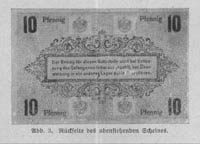Table of Contents
Media Index
CHAPTER 11
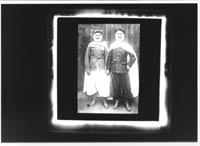
Two Arab prisoners of war, incarcerated in a German POW camp, pose for a photograph for a WPA Secretary.
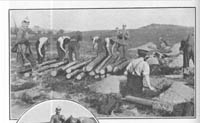
A labor detachment of British prisoners plane the bark off trees and dig trenches under the direction of German guards early in the war.
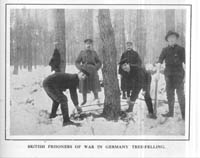
Two British sailors saw down a tree while another British prisoner of war holds an axe during some winter work. Wood was an important heating fuel in prison camps during the winter. Two German guards look on and observe their progress.

Indian prisoners of war rest and talk in the compound of a German prison camp. These men represented a wide range of people from the sub-continent.
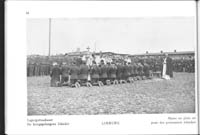
Irish prisoners at Limburg receive communion during an outdoor Roman Catholic service. The altar stands behind the priests as they administer the sacrament.

Portrait of Sir Roger Casement (1864-1916), Irish nationalist, was captured by the British and tried for high treason for his role in the Easter Rebellion in 1916.
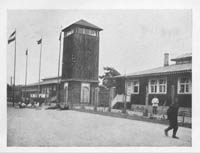
With the German imperial flag waving to the left, this photograph shows the entrance to the prison camp at Zossen-Wuensdorf. This watch tower was typical in most German prison camps and played an important role in camp security since sentries could keep track of activities within the facility, including escape attempts.

Color painting of the mosque at Zossen-Wunsdorf which shows the elaborate colors used to decorate the building. Muslim prisoners stand in front of the mosque in the prison compound.
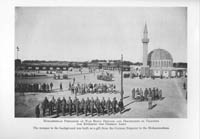
Muslim volunteers practice drilling in marching exercises under the direction of German NCO's in the prison compound at Zossen-Wuensdorf beside the mosque. These men volunteered to fight for the Sultan with the Turkish armies in the East against the British and the Russians.
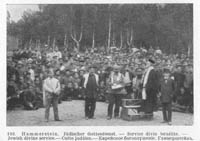
A rabbi leads an outdoor service for Russian prisoners of war from a set of stairs in the prison compound at Hammerstein. A large number of Russians have assembled to participate in the service, including a man in civilian clothing.
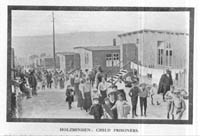
Children play in the streets of the prison camp at Holzminden outside of their one-story wooden barracks. The Germans incarcerated interned French families at Holzminden early in the war as enemy aliens. While the prison camp was segregated into men's and women's compounds at night, internees could visit other sections of the facility during the day.
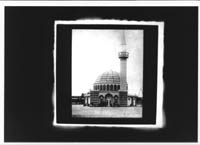
This photograph was taken by an American YMCA secretary of the mosque Kaiser Wilhelm II built for Muslim prisoners at Zossen-Wuensdorf. The Kaiser had long held the title of the friend of the Muslims and the propaganda camp at Zossen served three purposes. The facility became a recruitment center for captured Muslims to volunteer for service with the Sultan's armies in the Near East. The camp and the mosque demonstrated Germany's concern for the subjugated Islamic people in the Allied Powers' empires. In addition, the prison camp showed the German people that the Entente Powers had to rely on colonial troops to support their war effort.
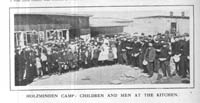
Internees, children, and French prisoners of war line up for their meals outside of the kitchen at Holzminden. The adults have soup bowls ready while the children carry dinner pails.
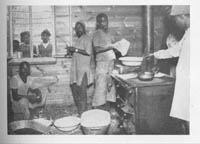
Indian prisoners prepare unleaven bread from a special wheat flour in an oven in the prison camp at Zossen-Wuensdorf. Indian POW's peer through the barbed-wire covered window to watch the bakers at work. As a propaganda camp designed to recruit Muslim prisoners, the Germans permitted the Indian POW's to prepare special meals that were not available in other camps.
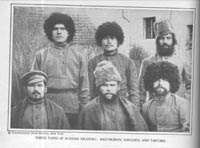
Three types of Russian prisoners pose for this group photograph: two Bashkirian prisoners (the men with the fur caps), a Kyrgyz (who is stting on the left with the Russian army field cap), and three Tartars (wearing the dark hats) from the Steppes of Russia. They represented the diversity of the tsarist armies fighting against the Central Powers.

German troops supervise Belgian prisoners in the construction of a new line of trenches outside of Brussels in 1914. Note that the trenches are not dug in a straight line to prevent enemy troops, who might seize a part of the trench system, from firing the length of the defensive line. Forcing POW's to construct fortifications was a violation of the Hague Conventions. This photograph may have been retouched--note the prisoner in the foreground. He appears as a shadow of a sentry in other copies of this photograph.
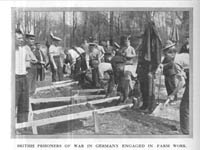
British prisoners of war work on a German farm, turning over the soil and sifting stones from the dirt. A Landsturm guard watches their work in the background.
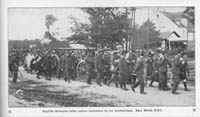
An English labor detachment pulls a wagon, with a German soldier on top, to work in the fields. Prisoners not only had to work in the fields but also replaced farm animals, especially for transportation. A German woman on the side of the road has caught the attention of some of the prisoners.

This general view of the prison barracks and compound at Wasbek is from a guard tower. A labor detachment of Russian prisoners enters the main gate after a day's work outside the facility. A German guard counts the POW's as they enter the camp.
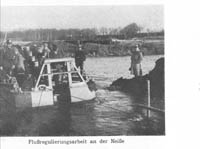
Prisoners on a ferry prepare to work on repairing the banks of the Neisse River in Silesia in support of a flood control project.
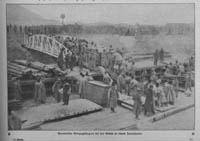
A Romanian prisoner Arbeitskommando loads a barge with lumber and boxes on the Danube river under the supervision of German troops.

German military authorities issued special prison money to POW's which could be used to purchase goods in the prison canteen. This is an example of a one-Pfennig bill from the Oberhofen prison camp. Special prison currency helped reduce opportunities for prisoners to bride German guards or to support their escape efforts because this currency was not valid outside of the facility.
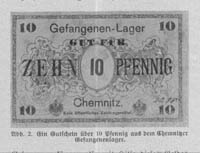
A ten-Pfennig note from the prison camp in Chemnitz. Prisoners could only use this currency to make purchases inside the camp.
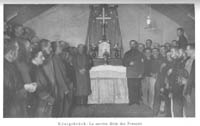
French prisoners stand along side the altar in the Catholic chapel at Koenigsbrueck. A German priest in uniform stands to the left of the altar. The spiritual care of POW's was a high priority for clerics who visited prisoners in camps.

Russian prisoners load bales of hay on a train. While World War I ushered in mechanization, horses remained a critical source of power in the German economy and war effort.
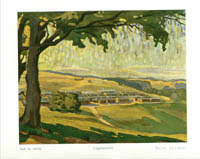
This water color picture provides a panoramic view of the prison camp at Muensingen, nestled in the hills of Wuerttemberg.

A Russian prisoner is hard at work ploughing a field behind a team of horses under the walls of Lichtenstein Castle. Allied POW's supplemented local agricultural labor which allowed the Germans to maintain food production despite the mobilization of farmers intothe German Army.
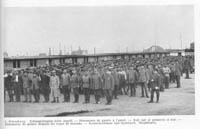
Russian, French, Belgian, and British POW's stand in line for their daily roll call in front of their barracks at Nuernberg. The Germans integrated the Allied prisoners within prison camps to avoid accusations of prejudice or mistreatment and, mockingly, to promote "comradery" among the Allied soldiers.

A labor detachment of British prisoners of war march through a German town on their way to a work assignment. Civilians watch their progress from the sidewalk and follow them on a bicycle.
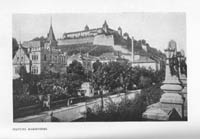
This photograph shows the Festung Marienberg strategically placed on a hill overlooking the city of Wuerzburg. The Germans incarcerated Allied officer prisoners in the fortress.
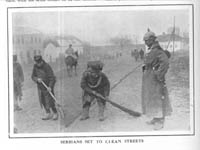
Serbian prisoners of war clean the streets of a German town with shovels and brooms under the gaze of a large German guard.
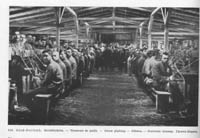
Russian prisoners take a break from work plaiting straw to make baskets and other goods used in the prison camp at Zittau (Gross Poritsch). The POW's are weaving inside a workshop at the facility. Note the German NCO's in the center aisle at the back of the room.
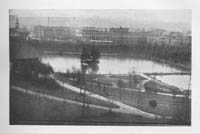
General view of the prison camp at Doebeln in Saxony, which is located across the park and small lake in the town.
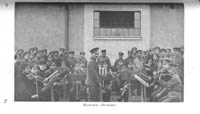
The stringed orchestra at Bautzen, composed of French and Russian musicians, performs outdoors for the prisoners. German soldiers are among the audience circling the orchestra. Note the white identification badge on the front of many of the prisoners' caps.
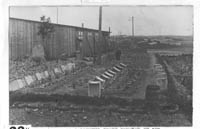
Prisoners augmented their meager diets at Soltau by gardening using seeds provided by a YMCA secretary.

British and French prisoners prepare to open packages from home in the packet mail room in the prison camp at Bautzen. They work under the supervision of a German non-commissioned officer, who is standing to the right.
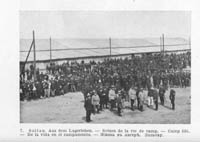
French prisoners of war line up outside their barrack in the compound at Soltau while German officers and non-commissioned officers converse in the foreground to the right.
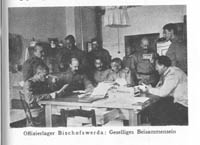
Russian officers share their mail at a table in their room at the officers' prison camp at Bischofswerda. They have received letters, postcards, and newspapers.
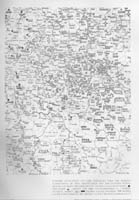
This is a section of a map showing the locations of Arbeitskommandos (Allied labor detachments) in the Kingdom of Saxony. The map is coded to idenitify agricultural labor, industrial labor, work for the state, and public interest projects. The map is further delineated identifying the Stammlagern (parent camps) where the prisoners were assigned; in this case, the prison camps at Golzern, Koenigsbrueck, and Chemnitz provided the man power for this labor.
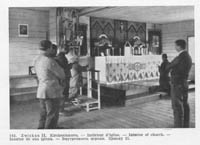
This is the interior of the Roman Catholic chapel at Zwickau. The photograph shows the altar and communion rail with some French prisoners praying. The Madonna and Child statue to the left of the altar and the fleur-de-lys pattern on the altar cloth indicate the church was used for Catholic masses. The church is relatively ornate with several pictures and a banner in the corner.

Secretary Daris A. Davis prepares circulating libraries for shipment to prisoners assigned to Arbeitskommandoes. Prisoners working in labor detachments could not visit the prison camp library and longed for access to books. Each traveling library carried a set of approximately thirty books. When the members of the labor detachment read all of the books, they could exchange the library for a new set of books.
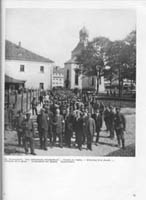
A group of civilian internees return to the prison at Traunstein from their Sunday morning service at a local church. The civilians are under guard by German soldiers and Landsturm.
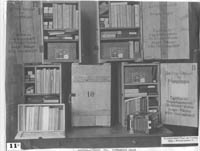
The War Prisoners' Aid Headquarters in Vienna sent these traveling recreation chests to labor detachments to make sure that prisoners detached from their parent camps still benefitted from the Red Triangle social program. Each wooden box contained reading material (books, magazines, spiritual tracts, and hymnals), musical instruments (accordions and harmonicas), games (dominoes and Mensch aergere dich nicht), and stationery. Easch chest was secured with a lock and chain to prevent the loss of materials.
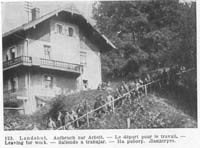
A labor detachment of French prisoners of war march down some stairs from the prison camp in Landshut on their way to their daily work. Children observe the men from the grass next to the house.

A number of YMCA recreation chests sit on the steps in front of a building. These chests contained books, games, musical instruments, and stationery and the Association sent them to German prisoners of war working on labor detachments across Britain and France. These men did not have access to the Red Triangle program and the YMCA sought to provide them some relief during their work outside of camp.

Russian prisoners of war work on wood carving and wicker projects outside their workshop in the prison camp at Aschaffenburg under the supervision of German non-commissioned officers. The workers have displayed examples of their handiwork on the table and on shelves, including a chair, baskets, and an ornate house.
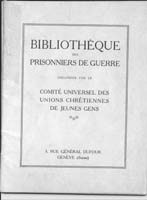
Cover of the Bibliotheque des prisonniers de guerre, published by the World's Alliance of YMCA's. This book listed the contents of the different series of circulating libraries available to prisoners of war working on Arbeitskommandos, far from prison camp libraries. The books which composed these libraries were published before the war and focused on history, literature, natural science, and vocational works.
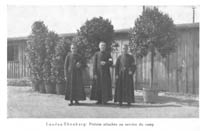
Three Roman Catholic priests stand beneath potted trees outside of a barrack at Landau-Ebenberg. There were a large number of French prisoners in this camp and the German authorities appointed priests to serve their spiritual needs.
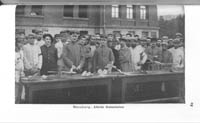
French and Russian enlisted prisoners display their wood working projects for two German officers outside of the main prison building at Wuerzburg. There are examples of airplanes, birds, and a windmill which demonstrated the wood working skills of the prisoners. Captivity in prison provided men with considerable time to practice their hobbies and exhibitions allowed the POW's to show off their abilities.
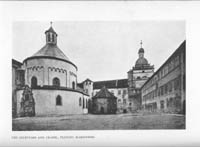
This is an exterior view of the fortress from the courtyard at Wuerzburg. The round building to the left is the castle's chapel.
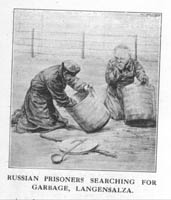
Food conditions were harsh for Russian prisoners of war in German prison camps who did not receive food parcels from home. This drawing depicts two Russian POW's scrounging in garbage cans for scraps of food to supplement their daily rations.
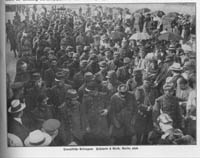
A detachment of French prisoners of war stand at attention in a German town, enroute to a prison camp. A number of German civilians stop to investigate the group out of curiosity, as these men may be their first view of the enemy. Germans would see a great many more Allied prisoners pass through their towns.
